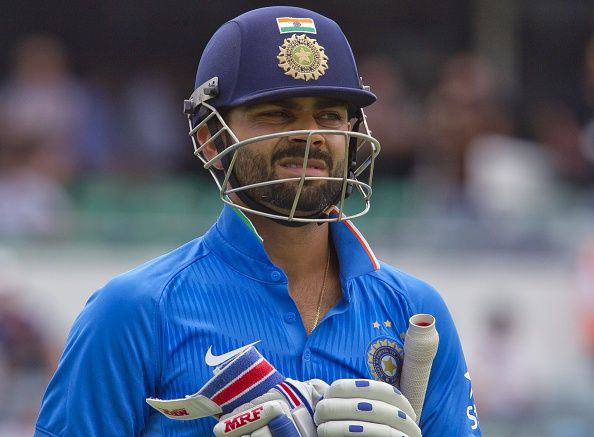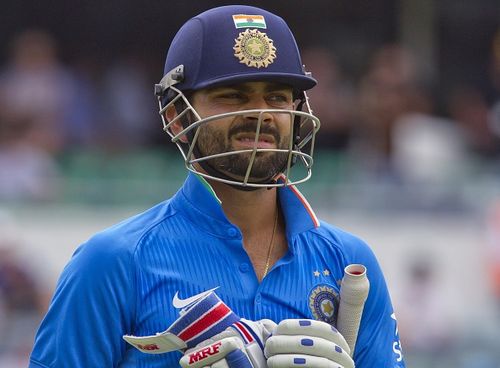
Why Virat Kohli should bat at No.4 in World Cup

I have been reading quite a few outlandish suggestions being made to get India out of the mess that they have entangled themselves in ahead of the World Cup: move Shikhar Dhawan to No.4, bat Stuart Binny as an opener and promote MS Dhoni in the batting order are only some of them.
You can discuss as much as you want, but none of these are happening this close to the tournament. Dhoni isn’t just Captain Cool, but Captain Stubborn too. This Indian team, in sticking to its ways, has lived by the sword so far and, as it appears, will die by the sword – oblivious to what is happening around it.
They started learning lessons when they were thrashed 3-0 in the ODI series in England in 2011 following the World Cup victory, and more than 3 years have passed by, they still are learning lessons. Are they learning it right, though?
Shikhar Dhawan – Out of form or outclassed?
Take Shikhar Dhawan’s ODI career for example. What ensued post his man-of-the-series performance in Champions Trophy 2013 reveals a lot. Sadly, though, the team hasn’t picked up anything of value.
Assignment 1: 5 ODIs against West Indies in West Indies. Dhawan averages 27. Inference: The law of averages was catching up to him after a dream run in England and he had lost a bit of form.
Assignment 2: 4 ODIs against Zimbabwe in Zimbabwe. Dhawan averages 52.25. Inference: Back in form.
Assignment 3: 6 ODIs in the ‘who scores more 300s’ series against Australia. Dhawan averages 56.8. It was followed by an average of 53 in 3 ODIs against West Indies, again at home. Inference: Dhawan was cashing in on his good form. (At least, that is what we were asked to believe. The theory didn’t last long, though.)
Assignment 4: He, then, travelled to South Africa, only to score 12 and 0 in the 2 ODIs. The misery got doubled up with him averaging 20.25 in the 4 ODIs in New Zealand. Inference: Experts reckoned Dhawan had again lost his form.
Assignment 5: Asia Cup on the dead Bangladesh decks. Dhawan averages 60.66. Dhawan, then, played 6 ODIs – 3 each against West Indies and Sri Lanka – in India. Inference: Dhawan, averaging 64.5, was back in his prime.
Assignment 6: Carlton Mid ODI tri-series in Australia, involving England as the third team. No prizes for guessing the outcome. The left-hander ended up averaging 12.25 in four matches. Inference: Dhawan is out of form.
The only exception to Dhawan’s case is his performances in England, where he has scored 518 runs in 9 matches at an average of 74. The ODI decks in England aren’t the same anymore (read this). Limited overs cricket performances in England during this period aren’t really indicators of how well a batsman can cope up with conditions assisting fast bowlers.
That India has failed to win a single ODI in South Africa, New Zealand and Australia after being crowned as the CT 2013 champions says something. It is important to understand that decks outside subcontinent can, at times, be subcontinental or flat.
Coming back to our case, the conclusion to it is simple: When Dhawan goes out of subcontinental conditions, he doesn’t go out of form, but gets outplayed.
When asked about Dhawan, Dhoni, however, had something different to say during the recently concluded tri-series: "That's where experience counts. It's not like every cricketer goes through a patch where he keeps scoring runs. Shikhar didn't have a Test series in England, but I felt he did decently well in the ODIs. So it's important for him to be himself, back his strengths, whatever his strength is because the change of format can really work in your favour.
"You have to be a bit more expressive. You can play your big shots. It is always about those first 10-15 minutes. You play a couple of good shots, you hit the middle of the bat and you are back in form. Again as I said, form is abstract.”
The Indian captain still believes that his opener is out of form. When you don’t identify what your problem is, how do you think you will solve it? And this is exactly why I think you would be wasting your time if you are trying to analyse something that is highly unlikely to happen: Dhawan will open the innings, Dhoni will bat at No.6 and Binny isn’t opening (rather he shouldn’t).
Kohli at No. 4 v Kohli at No. 3
So, let’s come to something that is in our control: Virat Kohli’s batting position. Dhoni has hinted at the possibility of Kohli batting down the order depending on the match situation. An individual’s batting position isn’t just decided by what is best for him; you also need to consider what is best for the team.
A simple case: Kohli did bat at No.3 in New Zealand and South Africa, but India weren’t able to win any of the 7 ODIs. It isn’t like the conventional way is working wonders, so why not try something else? Not that this move will solve everything that is wrong with the Indian team at the moment, but it will make sure they solve one of the few problems they are facing now: the inability to get contributions from both No.3 and No.4.
Will a No.4 get enough deliveries to influence the match?
Let’s take a look at four of the high-profile series that took place in Australia-New Zealand since October 2014 – the co-hosts of the upcoming World Cup – to find out when the No.4s of teams have come into bat, as the first concern that has been raised against Kohli’s demotion is that he wouldn’t get as many overs as he should to create an impact.
Australia v South Africa
Venue Australian No. 4 South African No. 4 Perth 35.2 overs 45.3 overs Perth 45.3 overs 43.1 overs Canberra 18.3 overs (189-2 in 31.3 overs) 23.2 overs (143-2 in 26.4 overs) MCG 39.1 overs 34.5 overs SCG 28.1 overs (137-2 in 21.5 overs) 17.5 overs (161-2 in 32.1 overs) Carlton Mid ODI Tri-series
Venue Australian No.4 England’s No. 4 India’s No. 4 SCG 37.2 overs 49.3 overs - MCG 27.2 overs (115-2 in 22.4 overs) - 42.4 overs Brisbane - DNB 35.3 overs Hobart 33.5 overs 27.4 overs (132-2 in 22.4 overs - Perth - 37.5 overs 22.5 overs (103-2 in 27.2 overs) Perth 33.5 overs 31.5 overs - New Zealand v South Africa
Venue New Zealand No. 4 South Africa No. 4 Mount Maunganui 40.4 overs 16.5 overs 42.1 overs Mount Maunganui 16.5 overs (169-2 in 33.1 overs) 41.5 overs New Zealand v Sri Lanka
Venue New Zealand No. 4 Sri Lankan No. 4 Christchurch 43.2 overs 42.4 overs Hamilton 37 overs 27.1 overs (116-2 in 22.5 overs) Nelson 42.3 overs 29.5 overs (113-2 in 20.1 overs) Dunedin 39.1 overs 23.5 overs (141-2 in 26.1 overs) Dunedin 36.2 overs 36.3 overs Wellington 46.3 overs 17.1 overs (175-2 in 32.5 overs) If you look at the tables above, you would understand that it hasn’t been the case at all. The number 4s have had plenty of batting time: out of the 37 occasions, the number 4s have come in before the 20-over mark 23 times – out of which 12 times before the 10-over mark.
Of the remaining 12 occasions, 11 times the teams have been in comfortable positions, which is indicated by the scores in brackets. So, either Kohli will be coming in with plenty of deliveries to face or when the team is in a good position. Whichever way, it doesn’t affect the team.
Interestingly, the only one instance of a No.4 coming in late involves India: the Men in Blue were 103-2 in 27.2 overs in their very recent ODI, against England at Perth. Although, the No.4 wasn’t Kohli. It was Suresh Raina. Kohli had come in at No.3, with the scoreboard reading 83-1 in 20.1 overs, which brings us to the next point.